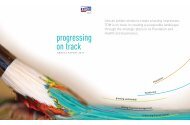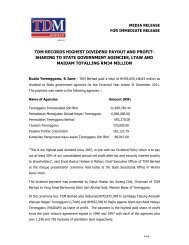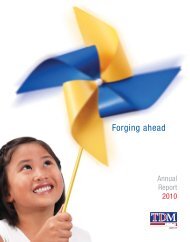2009 - TDM Berhad
2009 - TDM Berhad
2009 - TDM Berhad
- No tags were found...
Create successful ePaper yourself
Turn your PDF publications into a flip-book with our unique Google optimized e-Paper software.
<strong>TDM</strong> <strong>Berhad</strong> (6265-P) 75Notes to the Financial Statements2. Significant Accounting Policies (cont’d.)2.2 Summary of significant accounting policies (cont’d.)(f) Impairment of non-financial assets (cont’d.)An impairment loss is recognised in income statement in the period in which it arises, unless the asset is carried at a revaluedamount, in which case the impairment loss is accounted for as a revaluation decrease to the extent that the impairment lossdoes not exceed the amount held in the asset revaluation reserve for the same asset.Impairment loss on goodwill is not reversed in a subsequent period. An impairment loss for an asset other than goodwill isreversed if, and only if, there has been a change in the estimates used to determine the asset’s recoverable amount since thelast impairment loss was recognised. The carrying amount of an asset other than goodwill is increased to its revised recoverableamount, provided that this amount does not exceed the carrying amount that would have been determined (net of amortisationor depreciation) had no impairment loss been recognised for the asset in prior years. A reversal of impairment loss for an assetother than goodwill is recognised in income statement, unless the asset is carried at revalued amount, in which case, suchreversal is treated as a revaluation increase.(g)InventoriesInventories are stated at the lower of cost (determined on an actual basis) and net realisable value. In arriving at net realisablevalue, due allowance is made for all obsolete and slow moving items. Cost includes the purchase price of goods and attributableexpenditure.Net realisable value is the estimated selling price in the ordinary course of business less the estimated costs of completion andthe estimated costs necessary to make the sale.(h)Financial instrumentsFinancial instruments are recognised in the balance sheet when the Group has become a party to the contractual provisions ofthe instrument. Financial instruments are classifi ed as liabilities or equity in accordance with the substance of the contractualarrangement.Interest, dividends, gains and losses relating to a fi nancial instrument classifi ed as a liability, are reported as expense or income.Distributions to holders of fi nancial instruments classifi ed as equity are charged directly to equity. Financial instruments areoffset when the Group has a legally enforceable right to offset and intends to settle either on a net basis or to realise the assetand settle the liability simultaneously.(i)Cash and cash equivalentsFor the purposes of the cash fl ow statements, cash and cash equivalents include cash on hand and at bank and depositsat call which have an insignifi cant risk of changes in value, net of outstanding bank overdrafts.(ii)Other non-current investmentsNon-current investments other than investments in subsidiaries are stated at cost less impairment losses. The carryingamount of other non-current investments will be reduced to recognised a decline other than temporary in the value of theinvestments, such reduction being determined and made for each investment individually. On disposal of an investment,the difference between net disposal proceeds and its carrying amount is recognised in income statement.










